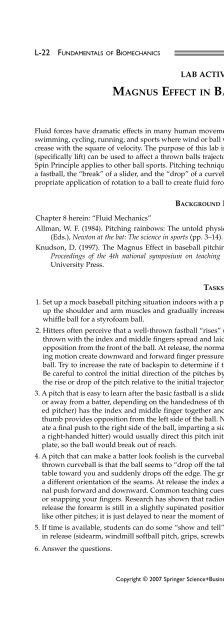Fundamentals of Biomechanics
Fundamentals of Biomechanics
Fundamentals of Biomechanics
You also want an ePaper? Increase the reach of your titles
YUMPU automatically turns print PDFs into web optimized ePapers that Google loves.
L-22 FUNDAMENTALS OF BIOMECHANICS<br />
LAB ACTIVITY 8<br />
MAGNUS EFFECT IN BASEBALL PITCHING<br />
Fluid forces have dramatic effects in many human movements. Fluid dynamics is <strong>of</strong> vital interest to coaches <strong>of</strong><br />
swimming, cycling, running, and sports where wind or ball velocities are great. The fluid forces <strong>of</strong> lift and drag increase<br />
with the square <strong>of</strong> velocity. The purpose <strong>of</strong> this lab is to improve your understanding <strong>of</strong> how fluid forces<br />
(specifically lift) can be used to affect a thrown balls trajectory. The example is in baseball pitching, although the<br />
Spin Principle applies to other ball sports. Pitching technique and the Magnus Effect are explored in the “rise” <strong>of</strong><br />
a fastball, the “break” <strong>of</strong> a slider, and the “drop” <strong>of</strong> a curveball. Skilled performance in many sports involves appropriate<br />
application <strong>of</strong> rotation to a ball to create fluid forces for an advantageous trajectory.<br />
BACKGROUND READING<br />
Chapter 8 herein: “Fluid Mechanics”<br />
Allman, W. F. (1984). Pitching rainbows: The untold physics <strong>of</strong> the curve ball. In E. W. Schrier & W. F. Allman<br />
(Eds.), Newton at the bat: The science in sports (pp. 3–14). New York: Charles Scribner & Sons.<br />
Knudson, D. (1997). The Magnus Effect in baseball pitching. In J. Wilkerson, K. Ludwig, & M. Butcher (Eds.),<br />
Proceedings <strong>of</strong> the 4th national symposium on teaching biomechanics (pp. 121–125). Denton: Texas Woman's<br />
University Press.<br />
TASKS<br />
1. Set up a mock baseball pitching situation indoors with a pitching rubber and home plate about 7 m apart. Warm<br />
up the shoulder and arm muscles and gradually increase throwing intensity with whiffle balls. Exchange the<br />
whiffle ball for a styr<strong>of</strong>oam ball.<br />
2. Hitters <strong>of</strong>ten perceive that a well-thrown fastball “rises” (seems to jump over their bat). The fastball is usually<br />
thrown with the index and middle fingers spread and laid across the seams <strong>of</strong> a ball, with the thumb providing<br />
opposition from the front <strong>of</strong> the ball. At release, the normal wrist flexion and radioulnar pronation <strong>of</strong> the throwing<br />
motion create downward and forward finger pressure on the ball. These finger forces create backspin on the<br />
ball. Try to increase the rate <strong>of</strong> backspin to determine if the ball will rise or just drop less than a similar pitch.<br />
Be careful to control the initial direction <strong>of</strong> the pitches by using visual references in the background. Estimate<br />
the rise or drop <strong>of</strong> the pitch relative to the initial trajectory at release.<br />
3. A pitch that is easy to learn after the basic fastball is a slider. A slider creates a lateral “break” that can be toward<br />
or away from a batter, depending on the handedness <strong>of</strong> the pitcher and batter. The grip for a slider (right-handed<br />
pitcher) has the index and middle finger together and shifted to the right side <strong>of</strong> the ball (rear view). The<br />
thumb provides opposition from the left side <strong>of</strong> the ball. Normal wrist flexion and pronation at release now create<br />
a final push to the right side <strong>of</strong> the ball, imparting a sidespin rotation. A typical right-handed pitcher (facing<br />
a right-handed hitter) would usually direct this pitch initially toward the center to the outside corner <strong>of</strong> home<br />
plate, so the ball would break out <strong>of</strong> reach.<br />
4. A pitch that can make a batter look foolish is the curveball. The common perception <strong>of</strong> hitters watching a wellthrown<br />
curveball is that the ball seems to “drop <strong>of</strong>f the table.” The ball looks like it is rolling along a horizontal<br />
table toward you and suddenly drops <strong>of</strong>f the edge. The grip for a curveball is similar to a fastball grip, but with<br />
a different orientation <strong>of</strong> the seams. At release the index and middle fingers are on top <strong>of</strong> the ball, making a final<br />
push forward and downward. Common teaching cues are to pull down at release like pulling down a shade<br />
or snapping your fingers. Research has shown that radioulnar pronation is delayed in the curveball, so that at<br />
release the forearm is still in a slightly supinated position. Curveballs are thrown with forearm pronation just<br />
like other pitches; it is just delayed to near the moment <strong>of</strong> release.<br />
5. If time is available, students can do some “show and tell” with other pitch variations. These include variations<br />
in release (sidearm, windmill s<strong>of</strong>tball pitch, grips, screwball, knuckleball, etc.).<br />
6. Answer the questions.<br />
Copyright © 2007 Springer Science+Business Media, LLC.All rights reserved.






